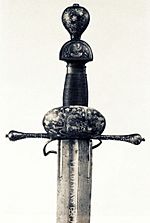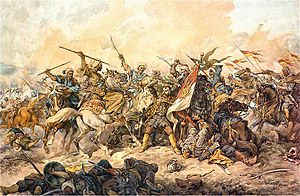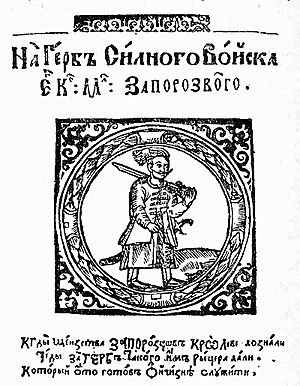Petro Konashevych-Sahaidachny facts for kids
Quick facts for kids
Petro Konashevych-Sahaidachny
Петро Конашевич–Сагайдачний |
|
|---|---|
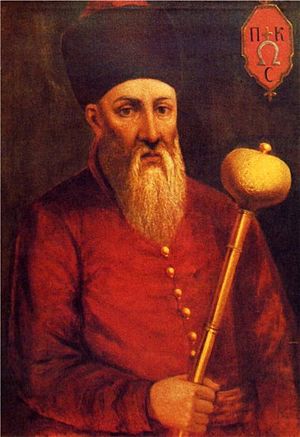 |
|
| Hetman of the HRG Host of Zaporizhia | |
| In office 1616–1622 |
|
| Preceded by | Vasyl Strilkovsky |
| Succeeded by | Olifer Holub |
| Personal details | |
| Born | near 1582 Kulchytsi, Polish–Lithuanian Commonwealth (now Ukraine) |
| Died | 20 April 1622 Kyiv, Polish–Lithuanian Commonwealth (now Ukraine) |
| Saint Petro Konashevych-Sahaidachny |
|
|---|---|
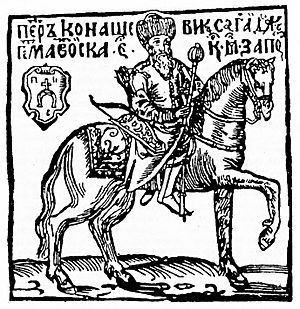 |
|
| Right-Believing Hetman | |
| Venerated in | Orthodox Church of Ukraine |
| Canonized | 25 May 2011 by Ukrainian Autocephalous Orthodox Church |
| Feast | 7 April |
Petro Konashevych-Sahaidachny (Ukrainian: Петро Конашевич-Сагайдачний; Polish: Piotr Konaszewicz-Sahajdaczny) was an important Ukrainian Cossack leader. He was born around 1582 in Kulchytsi, which is now part of Ukraine. He became the Hetman (a top military and political leader) of the Zaporozhian Cossacks from 1616 to 1622.
Sahaidachny was a skilled military commander on both land and sea. He helped turn the Cossack army into a strong, organized force. Under his leadership, Cossacks, Orthodox clergy, and peasants in Ukraine started to feel more united. His troops played a big part in the Battle of Khotyn in 1621 against the Turks. They also helped Polish Prince Władysław in his attempt to become the ruler of Russia in 1618.
In 2011, he was recognized as a Saint in the Orthodox Church of Ukraine. On April 20, 2022, he was also declared the patron saint of Ukraine's military forces.
Contents
Early Life and Education
Petro Konashevych was born into a Ukrainian noble family in Kulchytsy, a village near Sambir. His father's name was Konon, and "Konashevych" means "son of Konash."
He studied at the Ostroh Academy in Volhynia, a famous school at the time. One of his schoolmates was Meletiy Smotrytskyi, who wrote an important book on Slavic grammar. From a young age, Petro learned how to use weapons and ride horses.
He joined the Cossacks and took part in military trips to Moldavia in 1600 and Livonia in 1601. His bravery, leadership, and smart military plans were noticed by the Cossack leader Samiylo Kishka. Later, Sahaidachny moved to Lviv, and then to Kyiv, where he worked as an assistant and tutor for the family of a judge.
Key Military Actions
Sea Campaigns and Raids
By the late 1500s, Sahaidachny went to Zaporizhia. In 1605, he was chosen as a kosh otaman, a leader of the Zaporozhian Cossacks. Under his command, the Cossacks fought against the Crimean Tatars and the Turks.
The Cossack fleet captured the Turkish fortress of Varna and destroyed a large Turkish navy. Sahaidachny became famous for his sea raids on Crimea and Turkey. In 1616, he captured Caffa (Feodosia) on the Crimean peninsula. Caffa was a major center for the slave trade. He helped free many Christian men, women, and children who were held as slaves there.
Campaign in Muscovy
In 1618, Sahaidachny joined a group called the anti-Turkish Holy League. While he was fighting the Turks, the Polish–Lithuanian Commonwealth asked for his help in a war against Muscovy (the Russian Tsardom). They wanted him to bring 20,000 Cossacks to help Prince Władysław, the King of the Polish–Lithuanian Commonwealth, near Moscow.
Sahaidachny agreed and captured forts in cities like Putivl, Kursk, and Livny. Near Serpukhov, his Cossack army forced the Muscovite army to retreat. The Cossacks continued their advance towards Moscow. In September 1618, they made another Muscovite army retreat. Later, Sahaidachny's army joined with Jan Karol Chodkiewicz's forces and tried to capture Moscow.
In late October, Sahaidachny's army moved south from Moscow, capturing Serpukhov and Kaluga. This successful campaign caused panic among the Russians and led to the signing of the Truce of Deulino in December 1618. This truce resulted in the Polish–Lithuanian Commonwealth gaining a lot of new territory.
Some historians have noted that the Cossacks' actions during this campaign were very harsh. Sahaidachny later asked the Patriarch Teophanes III of Jerusalem for forgiveness for these actions.
After returning to Zaporizhia, Sahaidachny became not only a kosh otaman but also the Hetman of Ukraine. To avoid conflict with the Poles, he agreed to limit the official Cossack army size. He also stopped unauthorized Cossack sea raids into Turkey.
Restoring the Orthodox Church
Sahaidachny also worked to protect the religious and cultural rights of the Ukrainian people. In 1620, he and his entire Zaporozhian Host officially registered as students at the Kyiv Epiphany Brotherhood School. This was done to protect the school from being changed from an Orthodox school into a Roman Catholic one. He also helped create a cultural center in Kyiv and tried to unite the Cossack military with Ukrainian religious leaders and nobles.
In 1620, Sahaidachny convinced Patriarch Teophanes III of Jerusalem to help rebuild the Orthodox Church leadership in Ukraine. This leadership had been weakened by the creation of the Ukrainian Greek Catholic Church. As a result, new Orthodox bishops were appointed, including Iov Boretsky as the Metropolitan bishop of Kyiv. Sahaidachny promised to protect the Patriarch, who was seen as a spy by the Polish–Lithuanian Commonwealth. After the new bishops were in place, Sahaidachny escorted the Patriarch safely to the Ottoman border with a 3,000-man Cossack army.
The Polish–Lithuanian Commonwealth accepted these appointments because they wanted to keep Sahaidachny as an ally, especially after their army was defeated by the Turks in 1620.
The Battle of Khotyn
In 1621, a very important battle took place at Khotyn. About 80,000 Cossack and Polish troops fought against a huge Turkish army of 160,000 soldiers. The battle lasted for a whole month. Finally, the first snow forced the Turkish leader, Osman II, to pull back his weakened forces.
Sahaidachny and his army played a crucial role in this battle. Their actions forced the Turks to sign a peace treaty that was not favorable to them. During the battle, Sahaidachny was seriously wounded. After the battle, the Polish king sent Sahaidachny a special sword to show his thanks for his services.
Death and Legacy
Petro Konashevych-Sahaidachny died on April 20, 1622, in Kyiv. His death was caused by the wounds he received at the Battle of Khotyn. He was buried in the Bratsky Monastery in Kyiv. He left his money and property to schools in Kyiv and Lviv to support church causes.
Many people in Kyiv attended his funeral, showing how much he was respected. His writings, especially a work called About Union, were highly valued. In 1646, John III Sobieski, a Polish monarch, described Sahaidachny as "a man of great spirit who sought danger, did not care about his own life, was swift and energetic in battle, cautious, slept little and was sober... was careful at discussions, and non-talkative in conversations."
Polish historian Jan Widacki noted that Sahaidachny was one of the Zaporozhian hetmans most loyal to Poland. He supported cooperation between Polish and Ukrainian forces against their common enemies.
Modern Legacy
Petro Konashevych-Sahaidachny is remembered in many ways today:
- The Frigate "Hetman Sahaidachny" was the flagship of the Ukrainian Navy for over 20 years.
- The National Ground Forces Academy in Lviv is named after him.
- A monument dedicated to him was built in Kyiv's Kontraktova Square in 2001.
- After the 2014 events in Crimea, a monument to him in Sevastopol was moved to Kharkiv and unveiled there in 2015.
- Many streets in Ukraine are named after Petro Sahaidachny.
Images for kids
-
Krivak class frigate Hetman Sahaydachniy was the flagship of the Ukrainian navy until scuttled in Mykolaiv on the 28th of February during the 2022 Russian Invasion of Ukraine to prevent its capture by Russian forces.
-
Equestrian of Petro Konashevych-Sahaidachny at Kontraktova Square in Kyiv
-
Monument to Konashevych-Sahaidachny in Kharkiv
See also
- List of Ukrainian rulers




